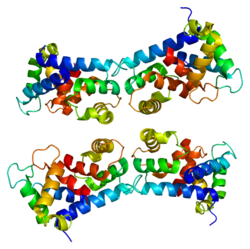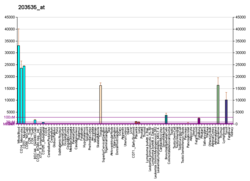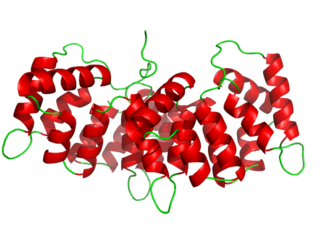
Annexin is a common name for a group of cellular proteins. They are mostly found in eukaryotic organisms.

The S100 proteins are a family of low molecular-weight proteins found in vertebrates characterized by two calcium-binding sites that have helix-loop-helix ("EF-hand-type") conformation. At least 21 different S100 proteins are known. They are encoded by a family of genes whose symbols use the S100 prefix, for example, S100A1, S100A2, S100A3. They are also considered as damage-associated molecular pattern molecules (DAMPs), and knockdown of aryl hydrocarbon receptor downregulates the expression of S100 proteins in THP-1 cells.

Calgranulin is an S100 calcium-binding protein that is expressed in multiple cell types, including renal epithelial cells and neutrophils.
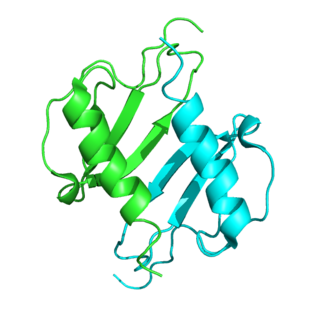
C-X-C motif chemokine 5 is a protein that in humans is encoded by the CXCL5 gene.
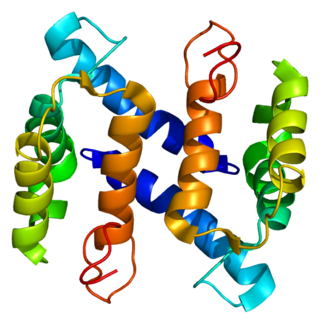
Protein S100-A4 (S100A4) is a protein that in humans is encoded by the S100A4 gene.

S100 calcium-binding protein A2 (S100A2) is a protein that in humans is encoded by the S100A2 gene and it is located on chromosome 1q21 with other S100 proteins.

S100 calcium-binding protein B (S100B) is a protein of the S-100 protein family.

S100 calcium-binding protein A8 (S100A8) is a protein that in humans is encoded by the S100A8 gene. It is also known as calgranulin A.

S100 calcium-binding protein A6 (S100A6) is a protein that in humans is encoded by the S100A6 gene.

S100 calcium-binding protein A12 (S100A12) is a protein that in humans is encoded by the S100A12 gene. Human S100A12, also known as calgranulin C, was first described in 1995.
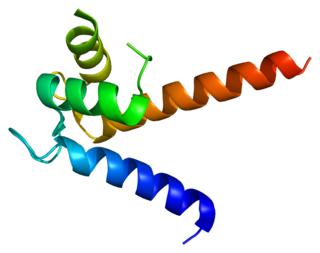
S100 calcium-binding protein P (S100P) is a protein that in humans is encoded by the S100P gene.

ATP-binding cassette transporter sub-family C member 11, also MRP8, is a membrane transporter that exports certain molecules from inside a cell. It is a protein that in humans is encoded by gene ABCC11.

Serine/threonine-protein kinase 38 is an enzyme that in humans is encoded by the STK38 gene.

ATP-binding cassette sub-family A member 3 is a protein that in humans is encoded by the ABCA3 gene.

Grancalcin is a protein that in humans is encoded by the GCA gene.
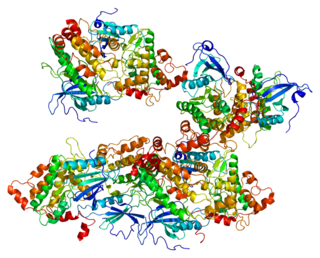
Death-associated protein kinase 2 is an enzyme that in humans is encoded by the DAPK2 gene.
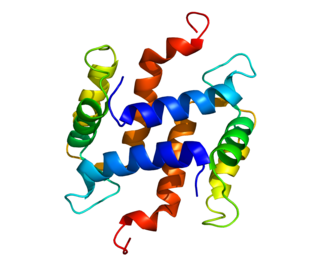
S100 calcium-binding protein A5 (S100A5) is a protein that in humans is encoded by the S100A5 gene.
Calprotectin is a complex of the mammalian proteins S100A8 and S100A9. Other names for calprotectin include MRP8-MRP14, calgranulin A and B, cystic fibrosis antigen, L1, 60BB antigen, and 27E10 antigen. The proteins exist as homodimers but preferentially exist as S100A8/A9 heterodimers or heterotetramers (calprotectin) with antimicrobial, proinflammatory and prothrombotic properties. In the presence of calcium, calprotectin is capable of sequestering the transition metals iron, manganese and zinc via chelation. This metal sequestration affords the complex antimicrobial properties. Calprotectin is the only known antimicrobial manganese sequestration protein complex. Calprotectin comprises as much as 60% of the soluble protein content of the cytosol of a neutrophil, and it is secreted by an unknown mechanism during inflammation. Faecal calprotectin has been used to detect intestinal inflammation and can serve as a biomarker for inflammatory bowel diseases. Blood-based calprotectin is used in diagnostics of multiple inflammatory diseases, including autoimmune diseases, like arthritis, and severe infections including sepsis.
The epidermal differentiation complex (EDC) is a gene complex comprising over fifty genes encoding proteins involved in the terminal differentiation and cornification of keratinocytes, the primary cell type of the epidermis. In humans, the complex is located on a 1.9 Mbp stretch within chromosome 1q21. The proteins encoded by EDC genes are closely related in terms of function, and evolutionarily they belong to three distinct gene families: the cornified envelope precursor family, the S100 protein family and the S100 fused type protein (SFTP) family.
